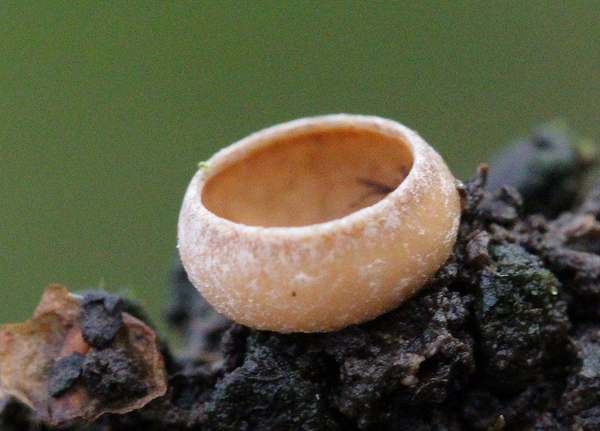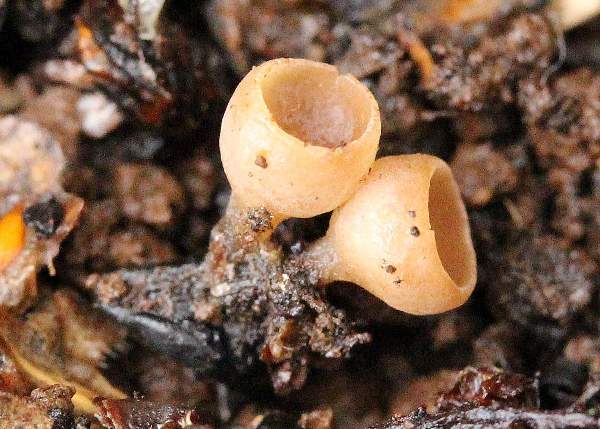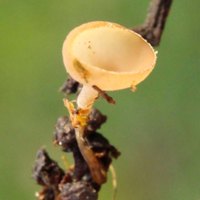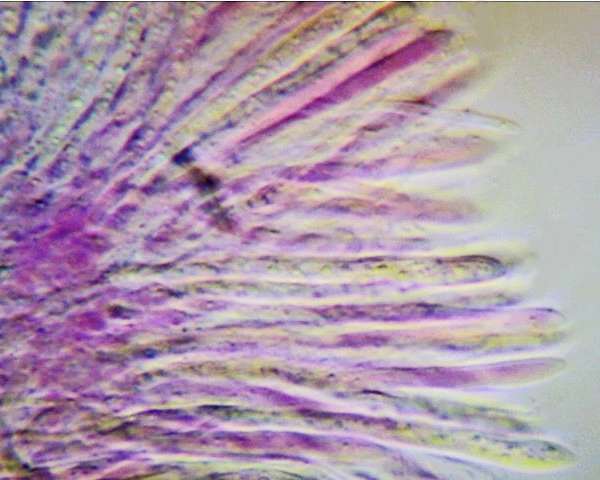Ciboria caucus - Alder Cup (Rebent.) Fuckel
Phylum: Ascomycota - Class: Leotiomycetes - Order: Helotiales - Family: Sclerotiniaceae
Distribution - Taxonomic History - Etymology - Identification - Reference Sources

In winter and early spring, many small ascomycete fungi fruit on fallen catkins and seed cones of various hardwood trees. Poplars, Alders and Willows are host substrates for several similar species.
Ciboria caucus fruits on the rotting (male) catkins of Black Alder Alnus glutinosa (a common riverside tree) and other members of the Alnus genus. The cups sometimes appear to be growing on rotting leaves, but careful excavation will show that the stem base emerges from a conceaaled catkin, which could even be buried just below the soil surface.
Distribution
In Britain and Ireland Ciboria caucus is an uncommon find. This spring-fruiting ascomycete has a geographical distribution that includes most of Europe. This species has also been recorded in North America.

Taxonomic history
When German botanist, briologist and mycologist Johann Friedrich Rebentisch (1772 - 1810) described this ascomycete fungus, in 1804, he gave it the scientific name Peziza caucus. Its currently accepted scientific name Ciboria caucus comes from an 1870 publication by another German mycologist, Karl Wilhelm Gottlieb Leopold Fuckel (1821 - 1876).
Synonyms of Ciboria caucus include Peziza caucus Rebent., Phialea caucus (Rebent.) Gillet, and Hymenoscyphus caucus (Rebent.) W. Phillips.
Etymology
Ciboria, the genus name, comes from the medieval Latin noun Ciborium, a drinking vessel - a reference to the chalice-like shape of the young apothecia. The specific epithet caucus also comes from medieval Latin and means a 'drinking vessel' - so I can only infer that the scientific name Ciboria caucus has the tautologous meaning 'chalice-like dirinking vessel.'.
Identification guide
 |
FruitbodyCup shaped, becoming flattened at maturity and sometimes splitting at the margin, individual fruitbodies (apothecia) are 3 to 10mm in diameter;margin with fine white cilia. The ochre fertile upper surface (the hymenophore) is smooth, while the infertile external surface is usually a little paler and slightly pruinose (frosted). Ochre at the top, the pruinose stem, 0.5 to 2 cm long and often sinuous, typically 0.5 to 1 mm in diameter, is mid brown towards the base. |
AsciEight-spored; 7-10 x 120-30µm; amyloid. ParaphysesCylindrical, up to 5µm in diameter, only slightly clavate at tip; extending just beyond the asci. |
|
SporesEllipsoidal, smooth, 7.5-10.5 x 4.5-6µm, hyaline, without oil drops. Spore printWhite. |
|
Odour/taste |
Not distinctive. |
Habitat & Ecological role |
Saprobic, usually on wet rotting male flowers (catkins) of Alders; also occasionally on rotting catkins of Poplars and Willows. |
Season |
Late winter and early spring, mainly January to March in Britain and Ireland). |
Similar species |
Ciboria viridifusca is a typically smaller cup fungus that grows mainly on the rotting female cone-like flowers of Alders and Poplars. |
Reference Sources
Fascinated by Fungi, 2nd Edition, Pat O'Reilly 2016, reprinted by Coch-y-bonddu Books in 2022.
Dennis, R.W.G. (1981). British Ascomycetes; Lubrecht & Cramer; ISBN: 3768205525.
Breitenbach, J. & Kränzlin, F. (1984). Fungi of Switzerland. Volume 1: Ascomycetes. Verlag Mykologia: Luzern, Switzerland.
Medardi, G. (2006). Ascomiceti d'Italia. Centro Studi Micologici: Trento.
Dictionary of the Fungi; Paul M. Kirk, Paul F. Cannon, David W. Minter and J. A. Stalpers; CABI, 2008
Taxonomic history and synonym information on these pages is drawn from many sources but in particular from the British Mycological Society's GB Checklist of Fungi.
Acknowledgements
This page includes pictures kindly contributed by Iris Millar.
Fascinated by Fungi. Back by popular demand, Pat O'Reilly's best-selling 450-page hardback book is available now. The latest second edition was republished with a sparkling new cover design in September 2022 by Coch-y-Bonddu Books. Full details and copies are available from the publisher's online bookshop...


